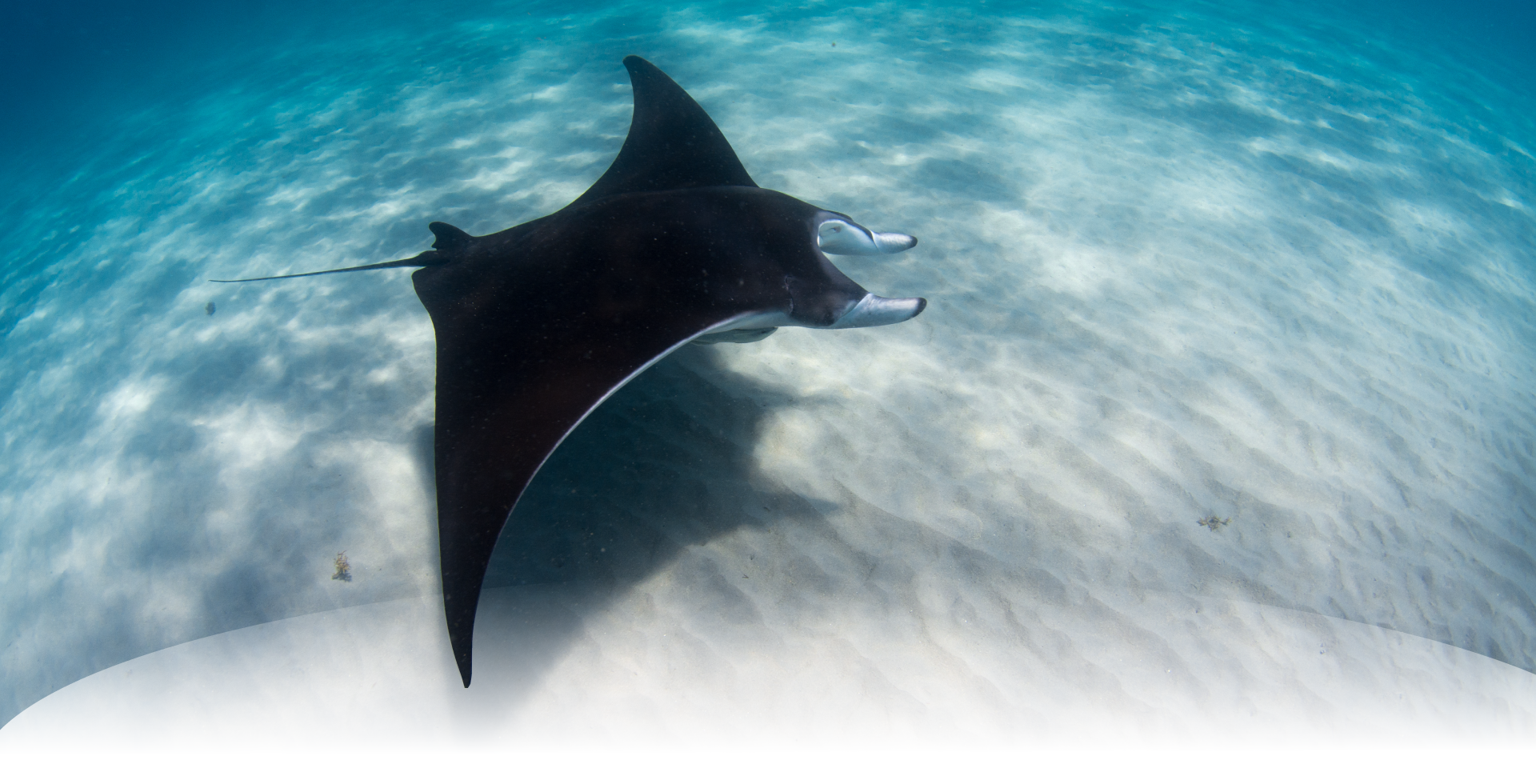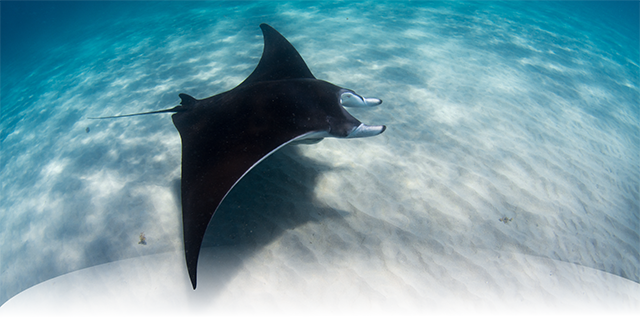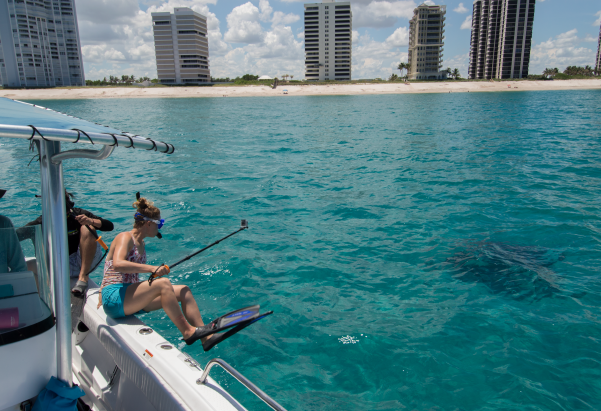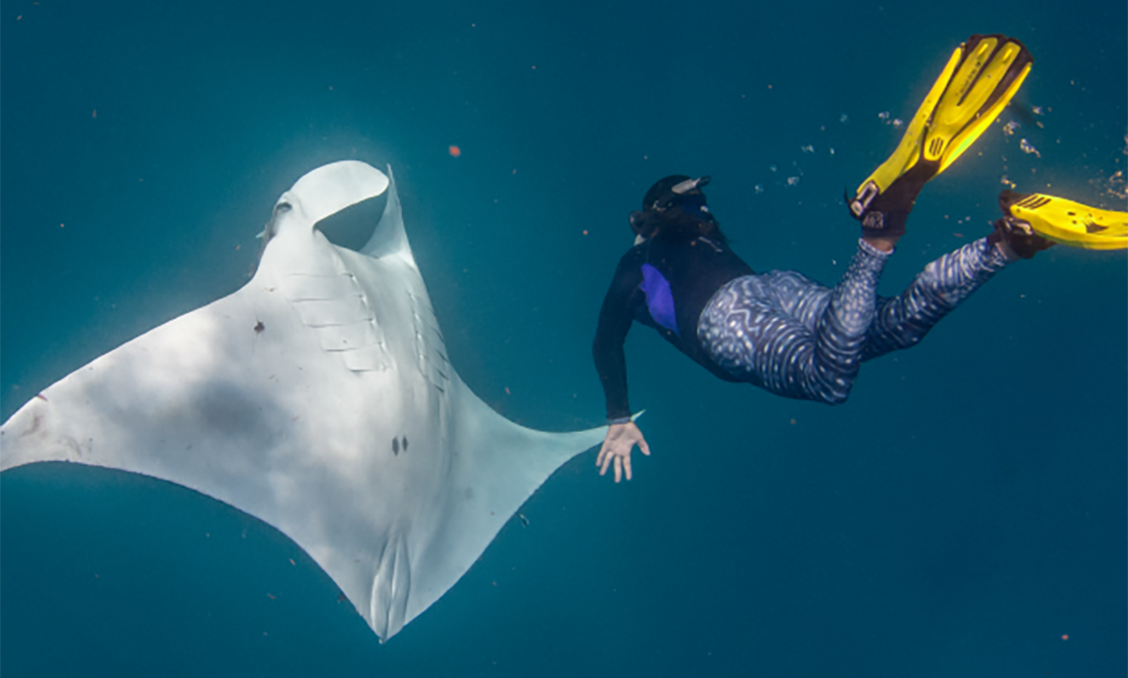

Ray of Light
FAU Graduate Uncovers First Urban Nursery Ground for Mantas off South Florida Coast
Story and Photography By Bethany Augliere
In her first semester of graduate school at Florida Atlantic University, Jessica Pate adopted a pair of feral kittens. She had no idea then, but that decision would ultimately change the course of her entire career, putting her on a path to discover the world’s first urban nursery ground for manta rays. Her findings were recently published in the journal of Endangered Species Research.
When Pate graduated from FAU in 2014, she left her cats with her sister and spent the next 18 months sailing the ocean as a marine science instructor for an educational study abroad organization. However, when Pate’s sister could no longer care for the cats, Pate knew they needed a home and moved back to Florida to care for them. Pate also knew her passion was to study manta rays.
In 2016, Pate founded the Florida Manta Project to learn more about the understudied manta rays off the coast of South Florida. “If it weren’t for my cats, I might not have started the Florida Manta Project,” said Pate, adding that the project is under the larger international nonprofit Marine Megafauna Foundation that protects threatened marine species and critical habitat worldwide.
Pate said she has been intrigued by rays since her days as a sea turtle biologist, watching them cruise the shoreline while she surveyed the beach for nests. She was surprised to see the rays so close to the beach, but even more surprised that there were virtually no published studies about these animals.
To study the giant rays, Pate surveys the coast from her 22-foot boat, from Boynton Beach to Jupiter looking for dark shadows at the surface. When the team spots a ray, someone carefully slips into the water to take photos and document behavior, such as rays feeding or traveling. In the last four years, the team has cataloged 59 individual rays, which can be identified by the unique markings on their bellies, like human fingerprints.
Based on the fact that these rays are mostly juveniles and use the area over consecutive years, Pate has determined that this region of South Florida is a potential nursery ground for young mantas. To date, there are just two other published studies on existing manta ray nurseries: in the Flower Gardens National Marine Sanctuary 100 miles off the coast of Texas and in Nusa Penida, Indonesia. But these areas are remote and far from urban centers, unlike the rays that Pate studies.
In 2018, manta rays were listed on the endangered species list and the baby mantas of South Florida face unique challenges being so close to human activity, including getting hit from boats or getting caught in fishing gear. About 27% of the rays were foul-hooked or entangled in fishing line. Whenever possible, Pate and her team remove hooks and line from the rays.

Collecting information about critical habitat and movement patterns of rays is crucial for their conservation. Pate hopes that her work can help establish South Florida as a designated critical habitat for the manta rays, which means that developers would have to consult the National Oceanic and Atmospheric Administration to ensure that any activities they authorize, fund, or carry out, are not likely to destroy or negatively modify the critical habitat, she said.
“As global manta ray populations decrease, it is important to protect these young manta rays from vessel strikes, fishing line entanglement, coastal development and water pollution,” Pate said.
Stephen Kajiura, a shark scientist and professor of biological sciences at the Charles E. Schmidt College of Science agrees. “Because there are basically no other scientists actively studying mantas in the state of Florida, the work that Jessica does is extremely valuable to both resource managers and the scientific community,” he said.
Since 2016, the project has grown in ways she could’ve never imagined, with full-time research interns, volunteers and collaborators. Since launching the project, she’s also added aerial surveys to her field work as well as the use of drones. Yet, there are still more questions to answer, like why the rays are using this particular area and where they go as adults. “I’m very much looking forward to answering these questions over the coming years and, probably, decades,” Pate said. “It has been a joy to begin to unlock some of their secrets.” ◆
FUN FACTS ABOUT MANTA RAYS
Manta rays — highly intelligent and highly threatened — are the largest rays in the world. The sea creatures live in tropical, subtropical and temperate ocean waters across the globe. Here’s a look at some fun facts about Mantas.
Mantas are filter feeders so they swim around with open mouths to scoop up tiny little plankton in the ocean.
National Oceanic and Atmospheric Administration
Female manta rays hit sexual maturity at around eight to 10 years old and tend to give birth once every couple of years, usually to one pup, or occasionally two. Pregnancy lasts about 12 to 13 months and manta rays give birth to live pups. Babies look like smaller version of adult manta rays when born and can immediately survive without parental care.
National Geographic
Manta rays have the biggest brain relative to body size of any fish in the ocean, and are surprisingly smart. They are considered by some scientists to have self-awareness because they’ve passed the mirror test. A 2016 study gave mantas mirrors. The rays behaved unusually, in ways that could imply self recognition. So far, it’s only been done by animals like dolphins, chimps and elephants.
Oceana, 2017
The giant manta ray is the world’s largest ray with a wingspan of up to 29 feet and can live up to 50 years.
National Oceanic and Atmospheric Administration and National Geographic
Microplastics pose a significant threat to manta rays, according to a recent study. They can ingest microplastics directly from polluted water or indirectly through contaminated prey.
Marine Megafauna Foundation
In general, there are two species of mantas: the giant manta and reef manta. It’s possible the mantas found in Florida are a third species, something biologists with Marine Megafauna Foundation are studying now.
Marine Megafauna Foundation

Jessica Pate, founder and lead scientist of the Florida Manta Project, dives down in an attempt to remove fishing gear from a young female manta ray, called Stevie Nicks. Entanglement with fishing gear, and boat strikes, are threats to these young rays.